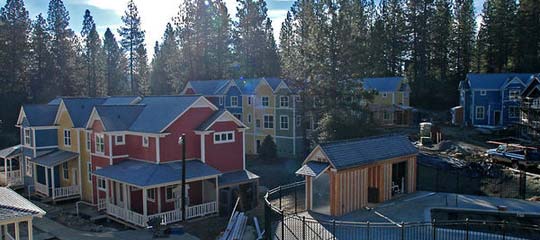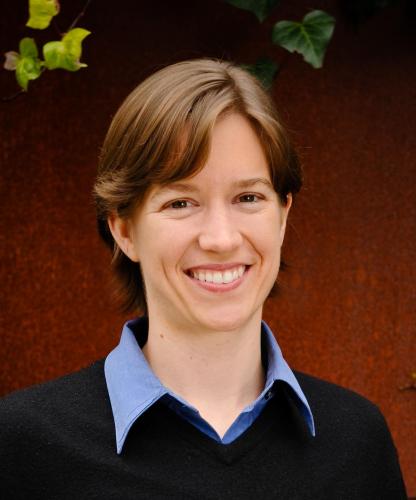I recently drove through Lakewood, a city 10 miles south of Los Angeles, just to see for myself what it looked like. Lakewood is the quintessential “fast homes” community—the housing equivalent of a fast-food order of “17,500 happy meals to go, please.”
In 1950, the Lakewood Park Company began building homes at the rate of 50 per day. They did not stop until 17,500 single family homes blanketed the former sugar beet fields, leaving little sign of the lakes or woods you’d expect to see in a place named “Lakewood.”
As I recall, Lakewood now looks more or less like this:

Lakewood is hardly unique. The post-WWII era brought us, like never before, individually wrapped lives—not shareable lives. We got mass-produced single-family homes, and a culture built around single-family expectations.
Fast homes shaped fast, isolated lives. In taking on their single-family dwellings and their single-family mortgages, families took on the heavy responsibility of meeting material needs independently.
Thus arose a fixation on convenience—on foods that were ready fast, on household appliances and gadgets that save time, on cars that get us to work with little hassle.
Since then, things have only gotten faster. We move so fast these days that we rarely slow down to talk to our neighbors, much less have them over for dinner.
The fastness pervades not only the way we build our homes and live in them, but also the way we buy and sell them.
In recent years, many of us made offers on houses, obtained financing, and quickly signed long, jargon-filled contracts and promissory notes without really reading them or fully understanding our promises. Today, so-called “successful” homeowners treat a home as an investment, buying when the market it low, selling when it’s high, moving into a bigger home, maybe flipping that one later, and on and on.
Our housing market also incentivizes wastefulness, as the cost of tearing down a perfectly good small house and replacing it with a “McMansion” or “Garage Mahal” is often small compared to the potential increase in property value. The housing market ends up looking, more or less, like this:

My realtor friend Cassandra Ferrera said it well: “Our homes should not be a stock market!”
Especially when stock markets are so prone to crashing. After a year of terrible foreclosures, it now seems that fast homes didn’t work out so well.
What is “Slow”?
Now is our opportunity to rebuild our lives around slow homes.
Slow is the opposite of “fast,” and the opposite of our industrialized society’s approach to growing and making food, building houses, manufacturing goods, extracting resources from the planet, and so on.
This approach has proven to be unsustainable to our planet, economy, health, and sanity—and “slow” movements are the response. Slow Food seeks to revive our “quiet material pleasure” in food, with a commitment to “good, clean, and fair food” and recognition of the “strong connections between plate and planet.” Slow Money is a movement to “bring money back down to earth” by building local economies and connecting investors to the places they live. There’s also Slow Parenting, Slow Medicine, Slow Travel, Slow Schools, Slow Cities, Slow Books, and Slow Living.
Good, Clean, Fair
And now Slow Homes. Recently, I had a slow lunch with two realtors from Regenerative Real Estate and one from Green Key Real Estate. These innovative realtors told me that they don’t just market houses, they market lifestyles. They told me how they help residents connect to their surrounding environments, live sustainably, and create communities that foster interaction and sharing.
That’s one way to describe a “slow homes movement.” There are, perhaps, other ways: sustainable homes, cooperative homes, intentional community, and so on. But to me, the word “slow” encompasses all that is “good, clean, and fair,” and it provides an even bigger umbrella under which to start rethinking everything about homes.

We are not the first to use the phrase “slow homes.” John Brown, an architect and realtor in Calgary, Canada, has already made significant headway into describing slow homes. His project, “Slow Home: Design School For Real Life,” has created a definition:
A Slow Home is SIMPLE, LIGHT, and OPEN. It is simple to use and fits the way you want to live. It is light on the environment and your finances and has open, flexible spaces that have a strong connection with the outdoors.
Brown’s ideas are beautiful, his designs are graceful, and they make sense.
Talking Slow Homes
Brown’s picture of Slow Homes can help us start an even longer conversation—or a movement, really.
Re-envisioning homes—something so intertwined with our economy, our forests, our daily lives, and our basic needs—is no small task, and it demands lots of participation.
As an attorney, I may add to the conversation with ideas about home ownership structures, finance, and land use. But mortgage brokers, lenders, realtors, planners, accountants, economists, ecologists, biologists, designers, artists, landscapers, engineers, and anyone with or without a home should be a part of this conversation. It’s a big job, and we’ve all got to do it.
And we have the added challenge of starting where we are and working with what is there—on a planet that is already covered in houses and residential buildings. We can’t start this slow homes movement in the countryside on the few remaining plots of unspoiled land. And we can’t just tear down the homes we have now and replace them.
Unlike the slow food movement, which can sort of get a fresh start with every harvest season, the slow homes movement will take place in apartment towers, concrete jungles, and tract homes. It means we must work and live inside these boxes, but think way outside the box as we recreate, retrofit, renovate, and redesign them.
In part two of “The Slow Homes Manifesto,” I propose six goals for the slow homes movement:
- Create housing that facilitates interaction, community, and sharing
- Make our homes part of a sustainable ecosystem and encourage residents to cook, eat, sleep, work, consume, and live more sustainably
- Build homes that are efficient, adaptable, and co-created by the people that live in them
- Provide comfortable, secure, healthy, and beautiful environments for residents
- Redesign our housing market and industry to ensure fairness and access
- Rethink city planning, zoning, and legal structures to facilitate our transition into slow homes and slow communities.
You can read the second part here—and please share your thoughts on slow homes by leaving a comment.









